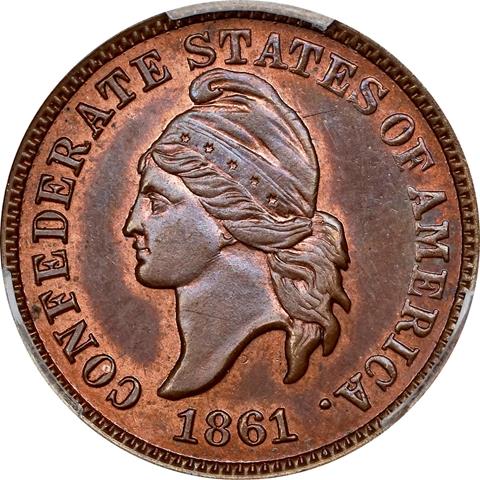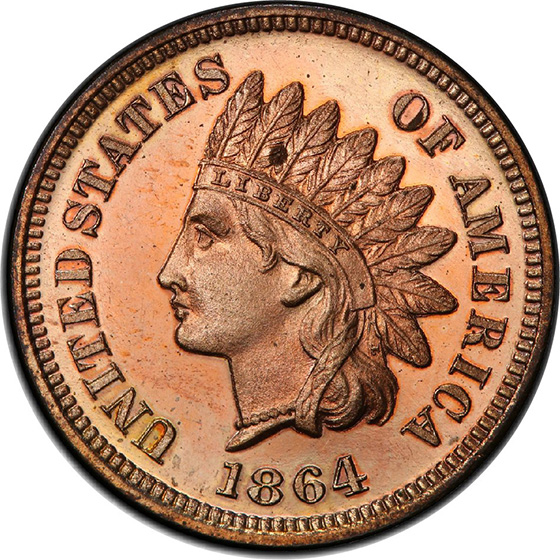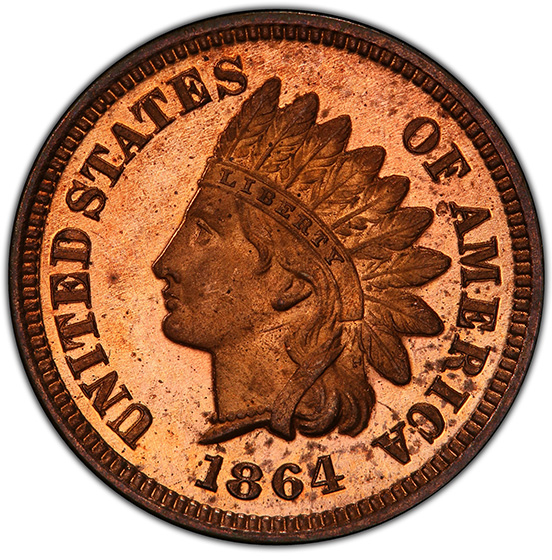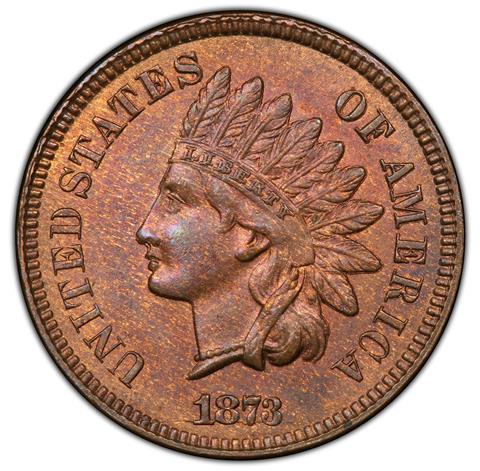(1859-1909)
Copper-Nickel (1859-1864)
There was nothing penny ante about the one cent piece in the mid-19th century: its buying power was substantial. The famed King Ranch in Texas, for example, came into being in 1853 when steamboat captain Richard King bought 15,500 acres for just $300—less than two cents per acre. For working-class Americans, 10 cents an hour was a living wage, so people understandably watched their “pennies” closely.
By the 1850s, many Americans actually were clamoring to have the cent’s clout diminished. What bothered them, however, wasn’t its buying power but its size: The copper cent then being minted was almost as large and heavy as today’s half dollar, and many had come to consider it simply too big for their britches.
The United States Mint responded to this concern in 1857 when it discontinued the large cent and half cent and introduced the nation’s first small-size cent, the Flying Eagle design. But it soon became obvious that the new cent—featuring a portrait of an eagle in flight—was a less-than-perfect solution: Because of deficiencies in its design, it often emerged weakly struck, especially at the eagle’s tail and wingtip.
The Flying Eagle cent had barely begun to circulate when Mint Director James Ross Snowden instructed Chief Engraver James B. Longacre to start preparing new designs, one of which would be chosen to replace it. Longacre must have felt mixed emotions at this assignment, for while he undoubtedly welcomed the chance to fashion the new design, the Flying Eagle portrait about to bite the dust was also his.
Ambivalent though he might have been, the chief engraver threw himself into the task with remarkable zeal, creating more than a dozen pattern cents. In this effort he was assisted by Anthony C. Paquet. Many of the cent patterns were refinements of the Flying Eagle coin, with modifications meant to make it easier to strike. On some, for example, the eagle’s tail and wingtip were shortened and moved away from the obverse’s rim; that way, they didn’t appear directly opposite the wreath on the reverse—the clash that had caused the weak-strike problem in the first place.
Given the volume and variety of these patterns, 1858 may well have witnessed the striking of more different U.S. cents than any other year. And many, if not all, reached the public—or at least the collecting public— since the Mint put them up for sale in sets of 12 different kinds.
At one point, Director Snowden suggested that Longacre fashion a head of Christopher Columbus for the cent. The chief engraver replied that while the idea was “entitled to consideration,” it seemed likely to stir opposition—for “how can it be relieved of any of the objections that have theretofore prevailed against the introduction of the head of [George] Washington upon the coinage of the United States?”
In the end, Longacre came up with an alternative that Snowden liked even better: a portrait of an Indian girl—or more likely a Caucasian—wearing a feathered headdress. The Mint director chose this design to replace the flying eagle with the start of production in January 1859, paired with a simple laurel wreath on the reverse— not only for aesthetic reasons, it would seem, but also because the combination had the lowest relief of all the ones proposed. Simplicity is the hallmark of the coin: Aside from the Indian portrait, the obverse bears only the date and the inscription UNITED STATES OF AMERICA, while there’s nothing on the reverse except the wreath and the words ONE CENT within it.
An oft-repeated story has it that Longacre modeled the “Indian” after his young daughter, Sarah. Evidence suggests that this is pure fantasy: Researchers have found drawings of virtually the same female head in Longacre sketchbooks from 10 years earlier, always with the same adult proportions and the same long “Greek” nose. And the artist himself referred to this profile in letters and official memoranda as being that of the Venus Accroupie, or “Crouching Venus”—a Greco-Roman statue displayed at that time in a Philadelphia museum.
Whatever the source of his inspiration, it’s clear that his idea was indeed inspired, for the Indian Head cent won immediate and enduring acclaim from the American public. In his book Numismatic Art in America, Cornelius Vermeule hails it as “perhaps the most beloved and typically American of any piece great or small in the American series.”
“Great art the coin was not,” Vermeule declares, “but it was one of the first products of the United States Mint to achieve the common touch and to identify itself with the transitions from frontier to industrial to social expansion during its decades of circulation . . .”
The Mint could not have chosen a more momentous time to introduce the coin: It entered the nation’s commerce on the eve of the Civil War. Perhaps in anticipation of the coming crisis, in 1860 Mint Director Snowden sought and obtained permission to add a national symbol—a small federal shield—at the top of the coin’s reverse. In a letter to Treasury Secretary Howell Cobb, Snowden explained that, “This will give it a more National character, and be a decided improvement upon the present coin.” That same year, the laurel wreath gave way to a thicker oak wreath.
Copper-nickel Indian Head cents were minted annually from 1859 through 1864, with a total of about 158 million being made—all in Philadelphia. Proofs were struck each year as well. The series contains no great rarities, and the only major variety is an 1860 cent on which the Indian’s bust is pointed, rather than rounded. Because the series is so short and has no real “stoppers,” many collect it by date. Many others prefer to collect it by type, acquiring one example of the 1859 and one to represent the years from 1860 through 1864, when the reverse was different.
When grading this design, the first places to show wear on the obverse will be the hair above the ear and the curl to the right of the ribbon; on the reverse, check the bow knot. Mint-state examples are relatively abundant in grades up to MS-65.
Like its Flying Eagle predecessor, the Indian Head cent started out as a copper-nickel coin, made from an alloy whose light color led to its being called a “white” cent. War-related hoarding caused the Mint to switch to a cheaper bronze alloy in 1864 and also to reduce the weight by a third, resulting in a thinner coin much like the cent we know today. But the Indian Head portrait remained in use for half a century before giving way to the Lincoln cent in 1909.
Bronze (1864-1909)
The shots at Fort Sumter that launched the Civil War didn’t ring out until April 12, 1861, but preparations for war were under way well before that including economic preparations. Anticipating the conflict, jittery Americans on both sides of the Mason-Dixon Line began hoarding gold and silver coins. The pace of this activity accelerated following the election of Abraham Lincoln to the presidency in November of 1860, for he was perceived as a hard-line Unionist unlikely to compromise with southern politicians. It reached fever pitch after Dec. 28, 1861, when New York banks suspended specie payments in response to the issuance of federal paper money which was not redeemable in coin. By the summer of 1862, precious metal coins all but disappeared from circulation.
Not being made of precious metal, cents continued to circulate for a few months longer. In fact, it seemed inconceivable that Americans would hoard cents. The large, intrinsically valuable copper cents used since the start of the nation’s coinage were replaced in 1857 by the smaller copper-nickel Flying Eagle cents—fiat issues, worth less as metal than as money. That was unusual in the mid-19th century; most U. S. coins had high intrinsic value, and Americans had come to expect and even demand this in their coinage. Nonetheless, the public had welcomed the large cents’ demise, considering the coins too cumbersome for ordinary use.
The new small cents—known as “white cents” because of their pale color—became even more popular in 1859 when, due to striking problems, the Mint replaced the original Flying Eagle design with a new one depicting a female clad in a feathered Indian headdress. This “Indian Head” portrait, not a native American profile but apparently modeled after the Greco-Roman statue Venus Accroupie, had widespread appeal, reinforcing the acceptance the white cents already enjoyed because of their handy size.
Production levels were high—far higher than those of the large cents they replaced—and it was common knowledge that the metal in each coin was worth less than one cent. But the Civil War shattered many accepted beliefs, including the perception that small-size, low-value cents were immune from hoarding.
Initially, bags of cents served as one of the primary means of payment for harried merchants deprived of silver coins. Before long, however, the cents too became a target for hoarders. They were, after all, government-issue coins, and as such were preferable to the all-but-irredeemable “shinplasters” (scrip and wildcat bank notes) being widely offered. Furthermore, the price of nickel—fueled by wartime demand—was rising quickly, giving these nickel-alloy coins greater intrinsic value. By December 1862, cents had joined gold and silver coins on the shelf.
That was when necessity gave birth to invention—not by Uncle Sam but by private entrepreneurs. To fill the vacuum left by the departure of federal coinage, merchants and promoters began producing cent-sized bronze tokens, generally bearing an implied or even explicit promise of redemption in goods, services or money. These “Civil War tokens” gained broad acceptance as a money substitute. Mint officials were duly impressed, and in 1864 they reshaped the cent in these tokens’ image, replacing the copper-nickel “white cent” with a slimmed-down version made of bronze.
Besides being darker in color, the new cent was one-third lighter in weight. Its diameter was unchanged, however, and it still bore the same Indian Head obverse design and simple wreath and shield reverse fashioned for its predecessor by the Mint’s chief engraver, James B. Longacre. The new coin’s components were less expensive than nickel, and this combined with its lower weight made it much cheaper to produce. It was also easier to strike, as bronze is much softer than nickel. And like the tokens it successfully replaced, it enjoyed ready acceptance from the public, effectively ending the shortage of cents in circulation.
Both kinds of cents were issued in 1864, with the bronze outnumbering the copper-nickel by about 3-to-1. Despite its higher mintage, the bronze cent provided the year’s scarcest variety: one on which Longacre’s initial “L” appears on the ribbon of the Indian’s bonnet. The designer didn’t add this until late in the year, so relatively few 1864 cents have it. Apparently, a large quantity of these “L” cents went to England, for many pieces were recovered from there in the 1950s and ‘60s.
Bronze Indian cents remained in production without interruption for nearly half a century before giving way to the Abraham Lincoln type in 1909. The design remained the same for the entire run except for minute changes in 1886, when the then chief engraver, Charles Barber, slightly lowered the relief and made a small change in the position of the bust. For all but the last two years, Indian Heads were struck only at the main mint in Philadelphia; in 1908 and 1909, the San Francisco branch struck cents, both times in very limited quantities. On these, the “S” mintmark appears below the wreath on the reverse.
Total mintage for the series reached almost 1.6 billion, along with 96,848 proofs. Annual production topped 100 million only once, in 1907, and sank below one million for just two issues: 1877 and 1909-S. At 309,000 pieces, 1909-S has the lowest mintage, but the 1877—at 852,500—is more valuable, because fewer examples were set aside. Other scarce issues include the 1869 with a doubled 9, 1872 and 1908-S. Proofs were struck every year, usually in the thousands, except for the earlier years which saw mintages under 1,000. The 1864 coins had the smallest proof mintages: 150 for the no “L” variety and only 20 for the with “L” coin, making it a major rarity. Counterfeits exist, particularly of coins dated 1877 and 1909-S, and to a lesser extent, the 1864 “L”, the 1866 to 1878 issues and 1908-S. Questionable pieces should always be authenticated.
When grading Indian Head cents, the first places to show wear on the obverse will be the hair above the ear and the curl to the right of the ribbon; on the reverse, check the bow knot.
Mint state examples exist in substantial quantities in grades up to MS-65, but their population drops sharply in MS-66 and above. Fully red coins, of course, are rarer still. Although the series is relatively long, it encompasses just 51 pieces—even including 1864 L, 1869/9 and the Open 3 and Closed 3 cents of 1873—because there are only two branch mint issues. Given this fact and the limited number of high-priced rarities, many collectors assemble complete date and mint sets. The series remains one of the most popular of all United States issues.
Coin Descriptions Provided by Numismatic Guaranty Corporation (NGC)
(Less text)




